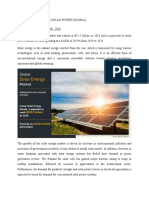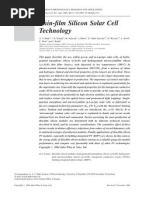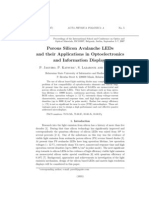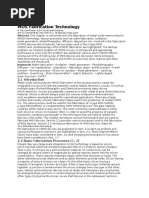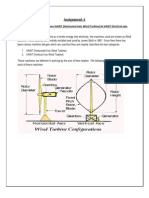Thin-Film-Silicon Solar Cells: J. Cárabe and J.J. GANDIA CIEMAT, 22 Avda. Complutense, E-28040 Madrid, Spain
Thin-Film-Silicon Solar Cells: J. Cárabe and J.J. GANDIA CIEMAT, 22 Avda. Complutense, E-28040 Madrid, Spain
Uploaded by
Long HoàngCopyright:
Available Formats
Thin-Film-Silicon Solar Cells: J. Cárabe and J.J. GANDIA CIEMAT, 22 Avda. Complutense, E-28040 Madrid, Spain
Thin-Film-Silicon Solar Cells: J. Cárabe and J.J. GANDIA CIEMAT, 22 Avda. Complutense, E-28040 Madrid, Spain
Uploaded by
Long HoàngOriginal Title
Copyright
Available Formats
Share this document
Did you find this document useful?
Is this content inappropriate?
Copyright:
Available Formats
Thin-Film-Silicon Solar Cells: J. Cárabe and J.J. GANDIA CIEMAT, 22 Avda. Complutense, E-28040 Madrid, Spain
Thin-Film-Silicon Solar Cells: J. Cárabe and J.J. GANDIA CIEMAT, 22 Avda. Complutense, E-28040 Madrid, Spain
Uploaded by
Long HoàngCopyright:
Available Formats
Contributed paper
OPTO-ELECTRONICS REVIEW 12(1), 1–6 (2004)
Thin-film-silicon solar cells
J. CÁRABE* and J.J. GANDIA
CIEMAT, 22 Avda. Complutense, E-28040 Madrid, Spain
The traditional development of photovoltaics has been based on crystalline-silicon wafer technology. In the early 1970’s,
however, a new approach arises based on the possibility to grow silicon in the form of a thin film onto a given substrate. Sev-
eral techniques are used for such a deposition, among which plasma-enhanced chemical vapour deposition (PECVD) is
clearly outstanding given its widespread use and success. More recently, very-high-frequency (VHP PECVD) and hot-wire
CVD have appeared as very promising and fast developing alternatives with important potential and actual advantages.
Thin-film technology introduces completely novel concepts and challenges in silicon photovoltaics. Low-temperature pro-
cesses particularly adequate for large-area devices open up not only very important cost-reduction potential, but also new
possibilities such as making semi-transparent or flexible modules. Additional important features are a highly automated pro-
duction system, an enormous potential for building integration, a good performance at realistic working temperatures
(around 40°C) and an excellent durability in outdoor conditions among others.
Photovoltaics are facing important challenges for the near future. Silicon-wafer technology is evolving towards making
thinner, cheaper, multicrystalline silicon. Thin-film-silicon researchers are in turn striving to make thicker, better, more crys-
talline films. Both ways seem to converge to new-generation photovoltaics in which wafer and thin-film technologies may be
used in a synergistic rather than competing manner. Silicon heterojunction cells (made up of a crystalline silicon absorber
onto which one or more thin-film silicon layers are deposited), such as the well-known HIT cell, are in the forefront of
photovoltaics and may represent a breakthrough in the next few years.
Keywords: photovoltaics, silicon solar cell, thin-film technology.
1. Introduction These milestones and the investigations made by Spear and
LeComber in 1975 [3], which demonstrate the possibility
Solar-module production has grown quickly in the last few to dope (both n-and p-type) amorphous silicon, were soon
years, making the solar-module market one of the fastest followed by the work by Carlson and Wronski, who in
growing ones in the world. Photovoltaics are dominated by 1976 announces the first experimental-a-Si:H solar cell
bulk mono- and multi-crystalline silicon (c-Si) solar cells made at RCA Laboratory [4]. This single junction p-i-n
which account for about 85% of the total production. Wa- a-Si:H solar cell deposited on a glass substrate coated with
fer PV technology is mainly limited by raw-material costs transparent conductive oxide (TCO) and aluminium back
whereas thin-film technologies allow for important reduc- contact exhibits 2.4% conversion efficiency. In 1983,
tion in semiconductor thickness because of the capacity of Matsuda [5] introduced another milestone in the develop-
certain materials to absorb most of the incident sunlight ment of thin-silicon technology by obtaining both p- and
within a few microns of thickness, in comparison to the n-type microcrystalline silicon (µc-Si). This new material
several hundred microns needed in wafer technology. In was used in 1987 by Hattori et al. [6] to make the first
addition, thin-film technology has an enormous potential in thin-film silicon solar cells having microcrystalline-silicon
cost reduction, based on the easiness to make robust, emitters. More recently, in the 1990’s, the need for a
large-area monolithic modules with a fully automatic fabri- better-quality, more stable absorber material, leads to an in-
cation procedure. Among thin-film solar cells, silicon dom- creasing interest in intrinsic microcrystalline silicon, with
inates the solar-module market by taking 9% of the global important milestones in 1992 by Faraji et al. [7] who used
PV market. very-high-frequency PECVD (VHF-PECVD) and in 1997
The beginning of amorphous-silicon PV goes back to by Rath et al. [8] who used hot-wire CVD (HW-CVD).
1965, when Sterling et al. [1] reported deposition of silicon All along this time, what was once a material called
onto a substrate using a silane glow discharge. Shortly af- amorphous silicon, has evolved into a whole family of
terwards, in 1969, Chittick et al. [2] obtained the first in- semiconductors based on different forms of silicon alloys
trinsic amorphous silicon of acceptable quality by PECVD. made by different deposition techniques having in common
the deposition in the form of thin films at low temperatures
*e-mail: (below 600°C and often around 300°C). It would be there-
julio.carabe@ciemat.es
Opto-Electron. Rev., 12, no. 1, 2004 J. Cárabe 1
Thin-film-silicon solar cells
fore appropriate to speak about thin-film silicon or deposi-
ted silicon. As will be demonstrated, this technology has
opened up new possibilities for the solution of a number of
important problems not only in photovoltaics, but in opto-
electronics in general. Its most relevant features are:
• considerable potential for cost reduction,
• possibility to use a wide variety of low-cost, even flexi-
ble substrates, as derived from the low-temperature pro-
cesses required,
• adequacy to make large-area devices,
• high degree of automation made possible by the mono-
lithic integration of modules, which in addition pro-
vides an excellent durability derived from module ro-
bustness and chemical stability,
• low temperature coefficients being responsible for a rel-
atively good performance of modules at realistic work-
ing temperatures (about 40°C) as compared to wafer
technology, Fig. 1. Basic scheme of a capacitively-coupled PECVD reactor.
• outstanding appearance and capacity for building inte-
gration, including semitransparent devices, making it
possible to make photovoltaic windows, tiles and other 2. Amorphous-silicon p-i-n cells and modules
elements with a high versatility and excellent aesthetic
results. Although thin-film silicon cells may have different struc-
Different preparation techniques have been tested to tures, both in substrate and superstrate configuration, one
make thin-film silicon. Sputtering and evaporation were simplified version of the most widely used superstrate
among the first ones in chronological order. The resulting structure can be shown as a good example for p-i-n
material had, nevertheless, a very high density of defects. thin-film silicon solar cells.
The preparation of amorphous silicon by PECVD of silane As it can be seen in Fig. 2, different layers are consecu-
(SiH4) and silane-containing mixtures allowed to obtain a tively deposited onto a common-glass superstrate. When
much higher quality, derived from the incorporation of hy- the process has finished, the device is illuminated by turn-
drogen coming from the decomposition of the gas mole- ing it upside down. Of particular importance is the need to
cules. These features have made PECVD the most widely keep the device at all fabrication steps at temperatures not
used preparation technique for thin-film silicon. An outline higher than the highest temperature attained in the previous
of a typical PECVD system is given in Fig. 1. steps. This means that this superstrate configuration allows
More recently, new deposition techniques have ap- the cheap deposition of SnO2:F by spray pirolysis (involv-
peared, such as very-high-frequency PECVD (VHF ing temperatures of 600°C to 800°C) at the beginning, so
PECVD) and hot-wire CVD (HWCVD), offering the possi- that the 200 to 300°C PECVD process is performed after-
bility to make higher-quality material (amorphous, nano- wards.
crystalline or microcrystalline) at the significantly higher As mentioned above, one of the main advantages of
growth rates (of the order of a few nanometers per second thin-film technology is the possibility to make monolithic
as compared to the traditional PECVD 1–2 Å/s). Table 1 modules in a highly automated process. This is illustrated
summarises some key optoelectronic properties and related in Fig. 3. The laser-scribing processes applied successively
parameters for prototypical PECVD thin-film silicon. to the TCO, the thin-film silicon layers as a whole and the
Table 1. Typical values of some parameters for standard PECVD thin-film silicon.
Parameter p-type a-Si:C:B Intrinsic a-Si n-type a-Si:P
Optical (Tauc) gap (eV) 2.0 1.75 1.75
Dark conductivity (S/cm) 10–6 10–10 10–3
Photoconductivity at 100 mW/cm2 AM 1.5 (S/cm) 10–5
ES-conductivity activation energy (eV) 0.45 0.85 0.20
Mobility-lifetime product (cm2/V) 10–7
Hydrogen content (%) 9–11
2 Opto-Electron. Rev., 12, no. 1, 2004 © 2004 COSiW SEP, Warsaw
Contributed paper
Fig. 4. Basic scheme of a monolithic integrated thin-film silicon
module.
The band diagram of such a p-i-n device is represented
in Fig. 5. A particularly important conclusion to be drawn
Fig. 2. Basic structure of a typical p-i-n thin-film silicon solar cell
thereof is that the absorber layer, the intrinsic one, is indeed
in superstrate configuration.
the space-charge zone. This means that:
• carrier transport is performed by drift, not by diffusion.
back contact, allow to separate the material deposited into a The mobility-lifetime product is now the key parameter
number of single cells which at the end turn out to be se- determining an effective carrier recombination. The av-
ries-connected. This process does not need any manual in- erage distance covered by a carrier before recombining
tervention, such as contact welding, wafer arrangement, is given by µtE, where E is the electric field present,
bonding, and other operations which make the fabrication • usual hypothesis (in wafer-based PV) of a negligible re-
of wafer modules and panels far less automatic. In addition, combination in the space-charge zone is not valid,
once the module has been encapsulated, the structure is • also usual superposition principle, according to which
highly robust both mechanically and chemically, resulting the J-V curve under illumination may be obtained just
in a durable product particularly resistant against changing by shifting the dark characteristics is not also valid.
temperatures and climatic conditions. The structure of the This last assertion can be illustrated by means of the
module as it comes out from the process line can be appre- equations applicable. Certainly, as the first approximation,
ciated in Fig. 4. one can use typical diode equation to which a photocurrent
Fig. 3. Scheme of the basic steps for fabrication of a thin-film silicon photovoltaic module.
Opto-Electron. Rev., 12, no. 1, 2004 J. Cárabe 3
Thin-film-silicon solar cells
nc-Si) – better µt product and making the intrinsic layer
thinner (tandem cells),
• to develop and apply new high-quality p- and n-type
emitters,
• to raise current density by improving light trapping
(TCO haze and similar techniques).
3. Commercial amorphous-silicon photovoltaic
products
Fig. 5. Band diagram of a p-i-n thin-film silicon solar cell. Wafer (mono- and multicrystalline) silicon dominates the
photovoltaic market. Only about 15% corresponds to
thin-films, new-generation ribbon silicon, and silicon
term has been added on the basis of the superposition prin- heterojunction cells. The situation is summarised in Fig. 6.
ciple With 9% of the total PV market, thin-film silicon commer-
cial products hold a particularly advantageous position in
J = - J L + J S (e qV nkT
- 1), (1) the consumer-electronics sector.
with
æ E ö
J S = J s* expç - a ÷ , (2)
è kT ø
and n = 18
. .
Nonetheless, these equations are not accurate enough to
describe the behaviour of the cell in most (if not in all)
cases, so the addition of a term accounting for the recombi-
nation in the intrinsic layer becomes necessary, as ex- Fig. 6. PV market share in 2001. Source PV News 21/4, April 2002.
pressed in the following equation [9]
æ q V - AJRs ö V - AJR The most important thin-film PV manufacturers in the
J = J S ç e nkT - 1÷ + s
- JL + world are indicated in Table 3.
ç ÷ R sh The products manufactured and commercialised by
è ø .
these and some auxiliary companies cover a wide range:
J L d i2 • modules (rigid or flexible) – area between 30×30 cm2
+ (3)
( mt ) ef [Vbi - (V - AJRs )] and 150×100 cm2 approximately, power between 5 and
50 W approximately, efficiency from 6 to 9% approxi-
The state-of-the-art stable efficiencies are given in Ta- mately,
ble 2. The present research and development on this field is • portable lamps,
focused on addressing a number of issues which represent • power supply units for stand-alone systems,
the main challenges of thin-film silicon PV technology to- • traffic signals,
day: • on-road SOS points,
• to increase fabrication throughput by raising growth • public lighting,
rate (from 1–2 to several tens Å/s), • weather-analysis systems,
• to minimise photodegradation (Staebler-Wronski ef- • consumer electronics; calculators, watches, battery
fect) by making a better absorbing material (µc-Si, chargers, ventilation systems, car sun roofs,
Table 2. Stable conversion efficiencies of the state-of-the-art thin-film silicon photovoltaic devices.
Single-junction Double-junction Triple-junction
Record cell 9.3% 12.4% 13.2%
Record module 10.4%
Commercial module 5% to 7% 9%
4 Opto-Electron. Rev., 12, no. 1, 2004 © 2004 COSiW SEP, Warsaw
Contributed paper
Table 3. Main thin-film silicon PV manufacturers in the world. photostability and fabrication throughput). This leading
force results in the following targets (taking standard amor-
Europe USA Japan
phous silicon as the reference starting point):
RWE Schott Solar (Germany) Unisolar Fuji • increased crystallinity,
• thicker active layer (~100–101 instead of ~10–1 µm),
Akzo Nobel (Netherlands) BP Solarex Kaneka
• higher growth rates.
Free-Energy Europe A rough view at the guidelines of both tendencies leads
Sanyo
(Netherlands) to conclude that the following characteristics define the key
silicon material in next-generation photovoltaics:
Intersolar (United Kingdom) Canon
• medium crystallinity (multi- or polycrystalline silicon),
Dunasolar (Hungary) Sharp • medium active-layer thickness, in the range from a few
microns to a few tens of microns,
• high fabrication throughput, either by epitaxy, fast so-
• pumping systems, lidification of melted silicon, fast film growth from gas-
• facades and roofs; solar tiles, semitransparent PV win- eous silicon sources or similar processes.
dows. Whereas it is unclear whether this kind of material will
The latter application is of particular relevance, given be obtained from the evolution of wafer technology, from
the outstanding features of thin-silicon PV technology, that of thin-film technology or even from hybrid ap-
which allow building integration in optimum conditions of proaches, the mutual convergence of these two research
modularity, aesthetics and versatility. The key features be- lines is more and more obvious. Furthermore, the charac-
hind this are: the possibility to make modules on large ar- teristics of new materials impose new limitations to device
eas, with irregular shapes, on flexible or bent surfaces and technology, thus requiring innovative solutions.
even semitransparent. For instance, the use of cheaper, non-highest-quality,
absorbers involves the risk of degradation of minor-
4. Thin-film silicon and new-generation ity-carrier lifetimes associated with high-temperature pro-
photovoltaics cesses such as those used in conventional wafer technology
for the formation of cell emitters. Additionally, the de-
For a long while, wafer and thin-film technologies have crease in active-layer thickness demands a more accurate
evolved as competing options, i.e. as if the solutions to the definition of the junction, and correspondingly, of emitter
technical problems could have come out from only one of thickness.
these two research lines. In the last few years, however, These requirements, added to other factors such as the
new possibilities have arisen on the basis of a number of search for automatic module-assembly approaches, the
technological approaches for the fabrication of inexpensive need to lower costs by simplifying technology and spend-
multicrystalline silicon, for the growth of polycrystalline ing less energy, or the tendency to produce large-area de-
silicon thin films on cheap substrates or for the deposition vices, have led to the development of a new PV sub-field:
of high-quality microcrystalline-silicon thin films at com- that of silicon-heterojunction solar cells (Si HJ). The
petitive growth rates. Among these techniques and materi- low-temperature processes (< 250°C) of this technology are
als are: edge-defined film-fed growth (EFG), string ribbon not only cost-effective by themselves, but also allow for
silicon, Silicon Film™, dendritic web growth, RGS silicon the use of low-cost substrates that cannot be annealed at
foil preparation [10] molecular-beam graphoepitaxial high temperatures, such as silicon ribbon and thin c-Si
growth (MBGE), solid-phase crystallisation (SPC), grown on glass [13].
zone-melting recrystallisation (ZMR), plasma-spray silicon Silicon-heterojunction cells (see Fig. 7), basically made
growth (PSSG), liquid-phase epitaxy (LPE) molecu- of a crystalline-silicon (mono- or multi-crystalline) wafer
lar-beam epitaxy (MBE), hot-wire CVD, VHF-PECVD and or ribbon absorber and one or two thin-film-silicon emit-
more [11,12]. ter(s), are excellent examples of technological convergence
Some of these approaches have evolved from a wafer and represent a promising option in seeking breakthroughs
technology as the possible ways to lower costs by produc- in photovoltaics.
ing solar-grade silicon ad hoc rather than consuming mate- Key features of silicon-heterojunction technology are
rial initially devised for the microelectronics industry. As [14]:
compared to CZ mono-c-Si, the subordination to lowering • very simple fabrication process,
costs leads to the following key features: • important cost-reduction capability,
• multicrystalline instead of monocrystalline silicon, • relatively high efficiencies, with a high potential for
• thinner active layers (~101 instead of ~102 µm), significant improvements.
• more efficient use of raw materials. Particularly remarkable is the work done by Sanyo who
The rest of the above mentioned techniques arise from has reported 21% efficiency on solar cells of this kind (so-
the need of the thin-film-silicon technology (basically called HIT) [15]. These solar cells have consequently attracted
PECVD) to overcome certain limitations (defect density, much attention of the international scientific community.
Opto-Electron. Rev., 12, no. 1, 2004 J. Cárabe 5
Thin-film-silicon solar cells
2. R.C. Chittick and J.H. Alexander, J. Electrochem. Soc. 116,
77 (1969).
3. W.E. Spear and P.G. LeComber, Solid State Commun. 17,
1193 (1975).
4. D.E. Carlson and C.R. Wronski, Appl. Phys. Lett. 28, 671
(1976).
5. A. Matsuda, J. Non-Cryst. Solids 59/60, 767 (1983).
6. Y. Hattori and D. Kruangam, Tech. Dig. PVSEC-3, 171
(1987).
7. M. Faraji, Appl. Phys. Lett. 60, 3289 (1992).
8. J.K. Rath, Techn. Dig. 9th Int. PVSEC, Miyazaki – Japan,
Fig. 7. Basic structure of n-on-p silicon heterojunction solar cell. 227 (1996).
9. J. Merten, IEEE Transactions on Electron Devices 45, 423
(1998).
Acknowledgements 10. J.P. Kalejs, Sol. En. Mat. & Solar Cells 72, 139–153 (2002).
11. A. Shah, J. Meier, E. Vallat-Sauvain, C. Droz, U. Kroll, N.
The author would like to thank his colleagues, M. Zeman Wyrsch, J. Guillet, and U. Graf, Thin Solid Films 403/404,
at Delft University of Technology and F. Roca and M. 179–187 (2002).
12. R.E.I. Schropp, Thin Solid Films 403/404, 17–25 (2002).
Tucci at ENEA Portici Research Centre for providing
13. M. Galluppi, R. Nacci, F. Ferrazza, W. Schmidt; J. Carabe,
very valuable information used in the elaboration of this
J.J. Gandia, F. Roca, and A. Bjorseth, Proc. 17th European
paper. Photovoltaic Solar Energy Conf., Munich, Germany,
1643–1645 (2001).
References 14. Y. Hamakawa, Appl. Surf. Science 142, 215–226 (1999).
15. H. Sakata, T. Nakai, T. Baba, M. Taguchi, S. Tsuge, K.
1. H.F. Sterling and R.C.G. Swann, Solid-State Electron. 8, Uchihashi and S. Kiyama, Proc. 28th IEEE PVSC, Anchor-
653 (1965). age (2000).
6 Opto-Electron. Rev., 12, no. 1, 2004 © 2004 COSiW SEP, Warsaw
You might also like
- IAMI Revision QuestionsDocument7 pagesIAMI Revision QuestionsStewart Long100% (1)
- History of Laos Manich 2Document177 pagesHistory of Laos Manich 2Long HoàngNo ratings yet
- Internship ReportDocument12 pagesInternship ReportRAKTIM CHAUDHURINo ratings yet
- Aalborg BoilerDocument2 pagesAalborg BoilerJunMamauagDelaCruz0% (1)
- Amorphous Silicon, Microcrystalline Silicon, and Thin-Film Polycrystalline Silicon Solar Cells PDFDocument6 pagesAmorphous Silicon, Microcrystalline Silicon, and Thin-Film Polycrystalline Silicon Solar Cells PDFCrystal WarrenNo ratings yet
- 1 s2.0 S1369702115000826 MainDocument7 pages1 s2.0 S1369702115000826 MainEmma BossuytNo ratings yet
- reinhard2013Document9 pagesreinhard2013saznin.cuet.15No ratings yet
- Thin Film Solar Cell WikiDocument7 pagesThin Film Solar Cell Wikivishrao1984No ratings yet
- D.K.M PPT at Solar CellDocument25 pagesD.K.M PPT at Solar CellDhanraj MeenaNo ratings yet
- Week 4 - EMIDocument10 pagesWeek 4 - EMIMuhammad ShahzaibNo ratings yet
- Low Cost Processing of CIGS Thin Film Solar Cells: M. Kaelin, D. Rudmann, A.N. TiwariDocument8 pagesLow Cost Processing of CIGS Thin Film Solar Cells: M. Kaelin, D. Rudmann, A.N. TiwariMuh SafarNo ratings yet
- Solar Cell TechnologyDocument30 pagesSolar Cell TechnologypatipanNo ratings yet
- Prospects For Sic Electronics and Sensors: N.G.Wright@Ncl - Ac.UkDocument6 pagesProspects For Sic Electronics and Sensors: N.G.Wright@Ncl - Ac.UkDaniel MorenoNo ratings yet
- Pip 3244Document7 pagesPip 3244Riski RamadaniNo ratings yet
- InTech-Chasing High Efficiency DSSC by Nano Structural Surface Engineering at Low Processing Temperature For Titanium Dioxide ElectrodesDocument19 pagesInTech-Chasing High Efficiency DSSC by Nano Structural Surface Engineering at Low Processing Temperature For Titanium Dioxide ElectrodesDeva RajNo ratings yet
- CHAPTER 5 - Fundamentals of Solar PV - BMEDocument8 pagesCHAPTER 5 - Fundamentals of Solar PV - BMEBIJETA KUNWARNo ratings yet
- Hybrid Solar CellDocument26 pagesHybrid Solar Celltatang setyabudiNo ratings yet
- Akgul 2017Document5 pagesAkgul 2017Eman NasirNo ratings yet
- Optp Electronics DeviceDocument6 pagesOptp Electronics Devicekaran007_mNo ratings yet
- Fabrication and Characterization of Highly Efficient Thin-Film Polycrystalline-Silicon Solar Cells Based On Aluminium-Induced CrystallizationDocument5 pagesFabrication and Characterization of Highly Efficient Thin-Film Polycrystalline-Silicon Solar Cells Based On Aluminium-Induced CrystallizationSarah GloverNo ratings yet
- 2003 Atomic Layer Deposition Chemistry Recent Developments and Future ChallengesDocument7 pages2003 Atomic Layer Deposition Chemistry Recent Developments and Future Challenges張大帥No ratings yet
- 1 s2.0 S0272884223015304 MainDocument8 pages1 s2.0 S0272884223015304 MainBernarda QuirogaNo ratings yet
- Lin Cot 2005Document9 pagesLin Cot 2005londemonNo ratings yet
- Performance of Different Photovoltaic Technologies For Amorphous Silicon (A-Si) and Copper Indium Gallium Di-Selenide (Cigs) Photovoltaic ModulesDocument11 pagesPerformance of Different Photovoltaic Technologies For Amorphous Silicon (A-Si) and Copper Indium Gallium Di-Selenide (Cigs) Photovoltaic ModulesOday Ibraheem ABdullahNo ratings yet
- Solar Cell Standard and Improved Manufacturing ProcessesDocument5 pagesSolar Cell Standard and Improved Manufacturing ProcessesTI Journals PublishingNo ratings yet
- Fabrication of Nanostructure Cds Thin Film On Nanocrystalline Porous SiliconDocument8 pagesFabrication of Nanostructure Cds Thin Film On Nanocrystalline Porous SiliconRup JoshiNo ratings yet
- CELTDocument12 pagesCELTAnkush KumarNo ratings yet
- Inorganic Photovoltaic CellsDocument8 pagesInorganic Photovoltaic CellsReivax50No ratings yet
- Fabrication of Flexible Dye Sensitized Solar Cells On Plastic SubstratesDocument16 pagesFabrication of Flexible Dye Sensitized Solar Cells On Plastic SubstratesMuhammad Bilal QadirNo ratings yet
- Transparent Conducting Zno:Al Films Via CCVD For Amorphous Silicon Solar CellsDocument4 pagesTransparent Conducting Zno:Al Films Via CCVD For Amorphous Silicon Solar CellsEidelsayedNo ratings yet
- Chemical Surface Deposition of Cds Ultra Thin Films From Aqueous SolutionsDocument26 pagesChemical Surface Deposition of Cds Ultra Thin Films From Aqueous SolutionsAnnisa TurrahmahNo ratings yet
- Thin Film Solar Cells: A Review: Journal of Information, Knowledge and Research in Electronics and CommunicationDocument3 pagesThin Film Solar Cells: A Review: Journal of Information, Knowledge and Research in Electronics and CommunicationEndalew kassahunNo ratings yet
- CAF Article PDFDocument4 pagesCAF Article PDFZetocha MilanNo ratings yet
- 1 s2.0 S0008622321008484 MainDocument9 pages1 s2.0 S0008622321008484 MainbudispacemanNo ratings yet
- Pergamon Pii:: Solid-State ElectronicsDocument14 pagesPergamon Pii:: Solid-State ElectronicsReza GoliNo ratings yet
- coatings-12-01948 (1)Document17 pagescoatings-12-01948 (1)AhmedNo ratings yet
- Silicon Nitride Films Deposited by RF Sputtering For Microstructure Fabrication in MEMSDocument11 pagesSilicon Nitride Films Deposited by RF Sputtering For Microstructure Fabrication in MEMSbehzadjaziNo ratings yet
- Si MS - 2Document8 pagesSi MS - 2jeronimo fernandez andujarNo ratings yet
- Thin Film SCDocument6 pagesThin Film SCalikaya12002No ratings yet
- Presentation 1 LicDocument28 pagesPresentation 1 LicreporterrajiniNo ratings yet
- 6ygggtgvvgbdddd FGGBV,,HHGB B GBV VffghyhgfDocument31 pages6ygggtgvvgbdddd FGGBV,,HHGB B GBV Vffghyhgfgazwang478No ratings yet
- C Rystalline and Thin-Film Silicon Solar Cells: State of The Art and Future PotentialDocument12 pagesC Rystalline and Thin-Film Silicon Solar Cells: State of The Art and Future PotentialRizwan KhanNo ratings yet
- CBD 1Document32 pagesCBD 1H Cuarto PeñaNo ratings yet
- Thin-Film Solar Cells Review of Materials TechnoloDocument6 pagesThin-Film Solar Cells Review of Materials TechnoloXDeathRay GamingNo ratings yet
- Progress in PV Technology Development Under The New Sunshine Program 997-2000 Solar Cell Manufacturing TechnologyDocument3 pagesProgress in PV Technology Development Under The New Sunshine Program 997-2000 Solar Cell Manufacturing Technologychinna_009No ratings yet
- Kosi WorkDocument11 pagesKosi WorkKermit CloudNo ratings yet
- Fabrication of NMOS TransistorDocument11 pagesFabrication of NMOS TransistorYogesh TiwariNo ratings yet
- SOI TechnologyDocument12 pagesSOI Technologycomputer48No ratings yet
- Micromachines 14 01200 v3Document37 pagesMicromachines 14 01200 v3rudy.riera0409No ratings yet
- A Comprehensive Review On Current Performance, Challenges and Progress in Thin Film Solar CellsDocument21 pagesA Comprehensive Review On Current Performance, Challenges and Progress in Thin Film Solar CellsREMO MosesNo ratings yet
- Advanced Materials - 2008 - Min - Bioinspired Self‐Cleaning Antireflection CoatingsDocument5 pagesAdvanced Materials - 2008 - Min - Bioinspired Self‐Cleaning Antireflection Coatingswalter.leandroNo ratings yet
- 4 Miro Zeman Delft University of TechnologyDocument46 pages4 Miro Zeman Delft University of TechnologyportlandguyzNo ratings yet
- High Efficiency Thin Film Solar Cells a Comprehensive OverviewDocument10 pagesHigh Efficiency Thin Film Solar Cells a Comprehensive Overviewdevadathanbijukumar007No ratings yet
- Impact of Defects On Quality Contact Systems For Photoelectric ConvertersDocument5 pagesImpact of Defects On Quality Contact Systems For Photoelectric ConvertersСергей ХрипкоNo ratings yet
- Vlsi TechniquesDocument55 pagesVlsi Techniquesselvi0412No ratings yet
- Complete Download A novel TiO2 nanotube arrays/MgTixOy multiphase-heterojunction film with high efficiency for photoelectrochemical cathodic protection Chang Feng & Zhuoyuan Chen & Jiangping Jing & Mengmeng Sun & Guiying Lu & Jing Tian & Jian Hou PDF All ChaptersDocument35 pagesComplete Download A novel TiO2 nanotube arrays/MgTixOy multiphase-heterojunction film with high efficiency for photoelectrochemical cathodic protection Chang Feng & Zhuoyuan Chen & Jiangping Jing & Mengmeng Sun & Guiying Lu & Jing Tian & Jian Hou PDF All Chapterspfohlkeadyym100% (1)
- Thin Film Silicon Solar CellDocument41 pagesThin Film Silicon Solar CellMukesh JindalNo ratings yet
- MOS Fabrication Technology: Abstract This Chapter Is Concerned With The Fabrication of Metal-Oxide-SemiconductorDocument7 pagesMOS Fabrication Technology: Abstract This Chapter Is Concerned With The Fabrication of Metal-Oxide-SemiconductorsammyNo ratings yet
- Chapter 5 Fabrication of Microelectronic DevicesDocument26 pagesChapter 5 Fabrication of Microelectronic Devicesmuhamadsaidi100% (2)
- W o L F o e S A B e H T N o S T N e M e L E R A L o S - L A N o Is N e M I D S e R U T C U RT S e Ti S o P M o CDocument5 pagesW o L F o e S A B e H T N o S T N e M e L E R A L o S - L A N o Is N e M I D S e R U T C U RT S e Ti S o P M o CСергей ХрипкоNo ratings yet
- Title: Author: Type of Research Paper: Statement of PurposeDocument2 pagesTitle: Author: Type of Research Paper: Statement of Purposebhoopesh_kumawatNo ratings yet
- Printable Solar CellsFrom EverandPrintable Solar CellsNurdan Demirci SankirNo ratings yet
- TheBoxerCodextranscriptionandtranslationofanillustratedlatesixteenthcenturySpanishmanuscriptconcerningthegeographyhistoryand PDFDocument5 pagesTheBoxerCodextranscriptionandtranslationofanillustratedlatesixteenthcenturySpanishmanuscriptconcerningthegeographyhistoryand PDFLong HoàngNo ratings yet
- Introduction To Semiconductor Physics and Physical Electronics and Circuit Models of TransistorsDocument3 pagesIntroduction To Semiconductor Physics and Physical Electronics and Circuit Models of TransistorsLong HoàngNo ratings yet
- Characteristic Features of Silumin Alloys Crystallization: Stanislaw PietrowskiDocument5 pagesCharacteristic Features of Silumin Alloys Crystallization: Stanislaw PietrowskiLong HoàngNo ratings yet
- Cadmium Telluride/Cadmium Sulfide Thin Films Solar Cells: A ReviewDocument10 pagesCadmium Telluride/Cadmium Sulfide Thin Films Solar Cells: A ReviewLong HoàngNo ratings yet
- Scaps Simulation of Zno/In S /cu SN S /mo Solar Cell: Phung Dinh Hoat, Do Phuc HaiDocument7 pagesScaps Simulation of Zno/In S /cu SN S /mo Solar Cell: Phung Dinh Hoat, Do Phuc HaiLong HoàngNo ratings yet
- Surface Electronic Transport Phenomena in SemiconductorsDocument1 pageSurface Electronic Transport Phenomena in SemiconductorsLong HoàngNo ratings yet
- Light Emitting Capacitor TechnologyDocument6 pagesLight Emitting Capacitor TechnologyLong HoàngNo ratings yet
- Surface Structure of The Tio Thin Film Photocatalyst: Et Al. (1, 3) - Environmental Pollutants And/Or Their inDocument6 pagesSurface Structure of The Tio Thin Film Photocatalyst: Et Al. (1, 3) - Environmental Pollutants And/Or Their inLong HoàngNo ratings yet
- Depth-Fused 3-D (DFD) Display With Multiple Viewing ZonesDocument8 pagesDepth-Fused 3-D (DFD) Display With Multiple Viewing ZonesLong HoàngNo ratings yet
- High Sensitivity Photodetector For Photon-Counting ApplicationsDocument24 pagesHigh Sensitivity Photodetector For Photon-Counting ApplicationsLong HoàngNo ratings yet
- Balasubramanian 2004Document12 pagesBalasubramanian 2004Long HoàngNo ratings yet
- A Comparative Study Between HAWT & VAWTDocument3 pagesA Comparative Study Between HAWT & VAWTMohit PandeyNo ratings yet
- Design and Simulation of Grid-Connected PhotovoltaDocument10 pagesDesign and Simulation of Grid-Connected PhotovoltamugahedNo ratings yet
- Homework05 Engineering Thermodynamics MENG 3320: Answer:0.945 KWDocument7 pagesHomework05 Engineering Thermodynamics MENG 3320: Answer:0.945 KWAndrew AlarconNo ratings yet
- Consructional - Features - Kaplan TurbineDocument13 pagesConsructional - Features - Kaplan TurbineASHITA K BNo ratings yet
- Boiler TrainingDocument21 pagesBoiler TrainingYadav GaneshNo ratings yet
- Water Turbine - Wikipedia, ..Document9 pagesWater Turbine - Wikipedia, ..manbkkNo ratings yet
- Steam CondenserDocument20 pagesSteam CondensernitinNo ratings yet
- MeasurIT Flexim ADM7407 Project EDF 0906Document1 pageMeasurIT Flexim ADM7407 Project EDF 0906cwiejkowskaNo ratings yet
- Steam Temperature Is One of The Most Challenging Control Loops in A Power Plant Boiler Because It Is Highly Nonlinear and Has A Long Dead Time and Time LagDocument4 pagesSteam Temperature Is One of The Most Challenging Control Loops in A Power Plant Boiler Because It Is Highly Nonlinear and Has A Long Dead Time and Time LagMourougapragash SubramanianNo ratings yet
- DM Plant and Boiler Operation Training.Document16 pagesDM Plant and Boiler Operation Training.gauravalok85No ratings yet
- BLOOM PresentationDocument6 pagesBLOOM Presentationrakesh makkapatiNo ratings yet
- Tidal EnergyDocument9 pagesTidal EnergydalerNo ratings yet
- About APS:: Years Product Warranty - Years Performance WarrantyDocument2 pagesAbout APS:: Years Product Warranty - Years Performance WarrantyP DirghNo ratings yet
- Energy Systems Presentation MaterialDocument208 pagesEnergy Systems Presentation MaterialLuis Enrique Leyva OvalleNo ratings yet
- Kutup Denizcilik Ve Ticaret LTD - Şti: M/E and D/G Overhaul Report Form:25GDocument3 pagesKutup Denizcilik Ve Ticaret LTD - Şti: M/E and D/G Overhaul Report Form:25Gdeli34No ratings yet
- Penawaran All SupplierDocument4 pagesPenawaran All Supplierwfs.attaqi04No ratings yet
- Meenakshi BorewellDocument4 pagesMeenakshi Borewellsugunec2013No ratings yet
- Reversible Open Circuit VoltageDocument1 pageReversible Open Circuit Voltageardian rahmat irawan SinagaNo ratings yet
- Fluid Mechanics QuestionsDocument3 pagesFluid Mechanics QuestionsWaleed UsmanNo ratings yet
- Promlem 1: A) The Discharge Through The Penstock. B) The Mean Annual Energy ProductionDocument4 pagesPromlem 1: A) The Discharge Through The Penstock. B) The Mean Annual Energy ProductionbkkbrazilNo ratings yet
- Eee - Simulink Titles ListDocument109 pagesEee - Simulink Titles ListVamsi Krishna GaraNo ratings yet
- An ISO 9001:2000, ISO 14001 & OSHAS 18001 Certified Company: Barauni Refinery by Imtiaz AlamDocument23 pagesAn ISO 9001:2000, ISO 14001 & OSHAS 18001 Certified Company: Barauni Refinery by Imtiaz AlamImtiaz AlamNo ratings yet
- NYCHA - Ravenswood Houses Heat PlanDocument3 pagesNYCHA - Ravenswood Houses Heat PlanColin PearceNo ratings yet
- Section 7 - F/602/2884 Understand and Apply Domestic Hot Water System Installation and Maintenance TechniquesDocument63 pagesSection 7 - F/602/2884 Understand and Apply Domestic Hot Water System Installation and Maintenance TechniquesAlberto Aranoa MartínNo ratings yet
- Basic Design Concepts of Industrial Plants System and EquipmentDocument30 pagesBasic Design Concepts of Industrial Plants System and EquipmentEam EvieNo ratings yet
- Reciprocating Compressor PDFDocument12 pagesReciprocating Compressor PDFredaNo ratings yet
- A Gas Turbine UnitDocument9 pagesA Gas Turbine UnitTITU NATHNo ratings yet


